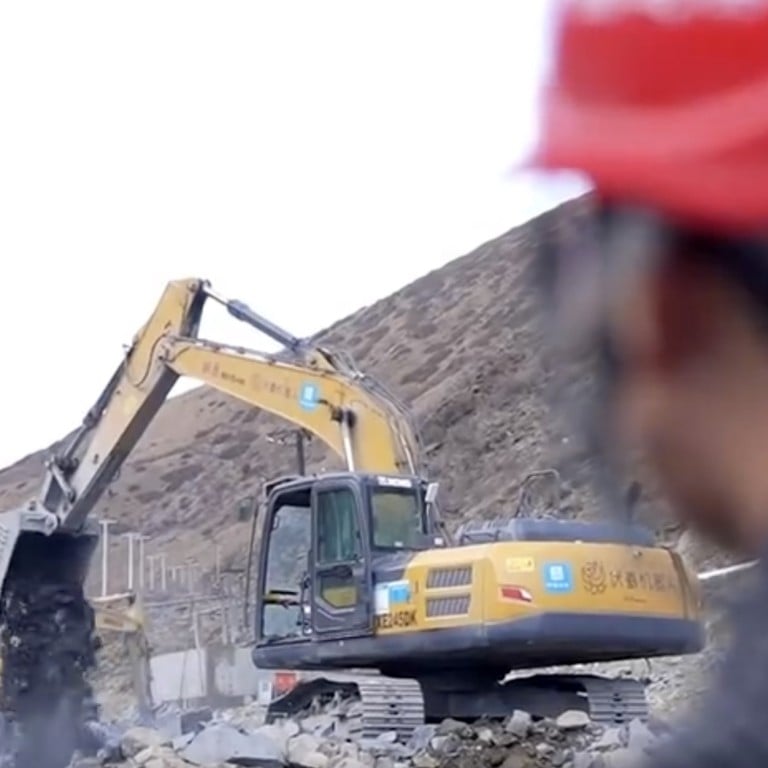
Could China’s economy-boosting infrastructure plans throw a contradictory monkey wrench in the works?
- Striving to reduce local government debt while boosting China’s local-level economies through investment is, in itself, a conflicting approach, analyst says
- Meanwhile, one of the world’s biggest makers of construction machinery says operating hours in China have fallen, suggesting fewer economy-boosting projects
While China is pinning hopes on an economic resurgence being fuelled by infrastructure projects across the country, recent industrial indicators suggest that such engines for growth may not yet be firing on all cylinders.
Japan’s Komatsu, one of the world’s top makers of construction machinery, has reported that its excavator operation hours in China during January declined by 11.4 per cent from December. And the firm’s overall equipment-operating time for all of last year saw a 3.2 per cent drop from 2022, when China’s stringent pandemic policies were still in place.
Yet, infrastructure still appears to be a main focus of investment, despite attempts to boost resources in “new strategic industries” and “hi-tech manufacturing”, according to provincial-level meetings that have been taking place over the past month.
China’s growth being held back by ‘protectionism’ at local level, Beijing told
Speaking to the Post on Thursday, economist Yu Miaojie, who is also the president of Liaoning University, noted how China’s leadership has identified “investment” as a major accelerator for its economy. Therefore, Yu expected that policy would remain focused on “increasing government spending and lowering taxes”.
Guangdong, which boasts China’s largest provincial economy, has set a 2024 budget of 598.6 billion yuan (US$83.3 billion) for major infrastructure projects, including roads and bridges, while earmarking 150 billion yuan for projects in “new strategic industries”, including information technology, biotechnology, hi-tech manufacturing and new materials.
Peng Peng, executive chairman of the Guangdong Society of Reform, said Guangdong’s plan showed how local governments are still relying heavily on infrastructure for economic growth.
“When there are no fundamental changes to the economic outlook, stability in terms of growth and expectations could be more important than anything else,” Peng said.
“Industry-focused investments also tend to be allocated for mega projects, showing that they are government-led areas of focus,” Peng added. “On the other hand, there is still not enough private investment in these areas.”
Zhejiang province in eastern China has disclosed that 87 large-scale manufacturing projects, at a total cost of 181.3 billion yuan, will come from private enterprises this year. And it said that the number of projects backed by private companies has reached “a new high” in terms of proportion of investments.
Meanwhile, some provinces in China’s central and western regions have plans to invest in energy storage, as the nation has put added emphasis on the need to develop green tech and industries tied to renewable energy.
The two biggest industry-based investments in Shaanxi province’s 3.96 trillion yuan annual budget were both energy-transition projects that each cost more than 100 billion yuan.
Among Anhui province’s 460 budgeted projects, 55 per cent fall under the category of new strategic industries.
Beyond China’s boondoggles, where will investments go when even water is a risk?
He Jun, a senior analyst with Beijing-based public policy consultancy Anbound, said that while local governments attempt to ramp up hi-tech investments, there is still a long way to go before fundamental structural changes are realised.
“While the proportion of hi-tech manufacturing is increasing … basic infrastructure investment still takes up a larger proportion of the overall investment structure. So, as we see some changes in the investment structure, we should also see that government-led investments tend to have strong inertia,” He said.
Meanwhile, He said that as private and foreign enterprises still lack confidence in China’s economy, this looks to also affect their “quality of investment”.
“If the government continues to be the main leader in investment projects, this must be a problematic approach, and the investment outcome would therefore be limited,” He said.
The government needs to get its priorities straight
Peng said that Beijing’s approach to invigorate local economies would continue to face a dilemma of driving growth and creating more local debt.
China’s Ministry of Finance said in November that the outstanding debt held by local governments had reached a record high in October, surpassing 40 trillion yuan. The previous record high was about 30 trillion yuan, reached in 2021.
“Avoiding the continuous expansion of local government debt while wanting to drive the economy through investment is, in itself, a conflicting approach,” Peng said. “The current pressure is especially daunting given the lack of momentum in economic growth and [diminished] confidence in investment.
“The government needs to get its priorities straight.”

